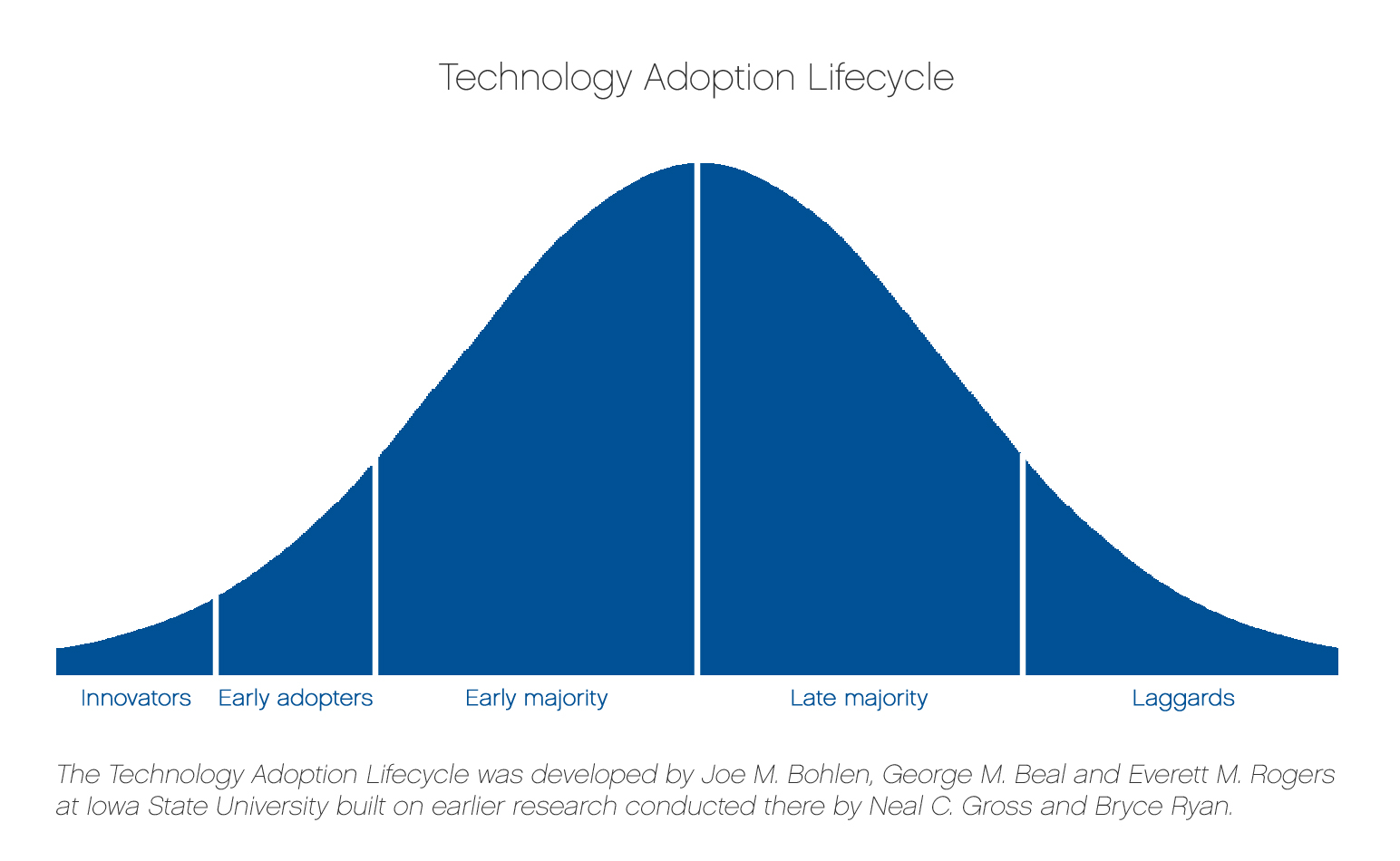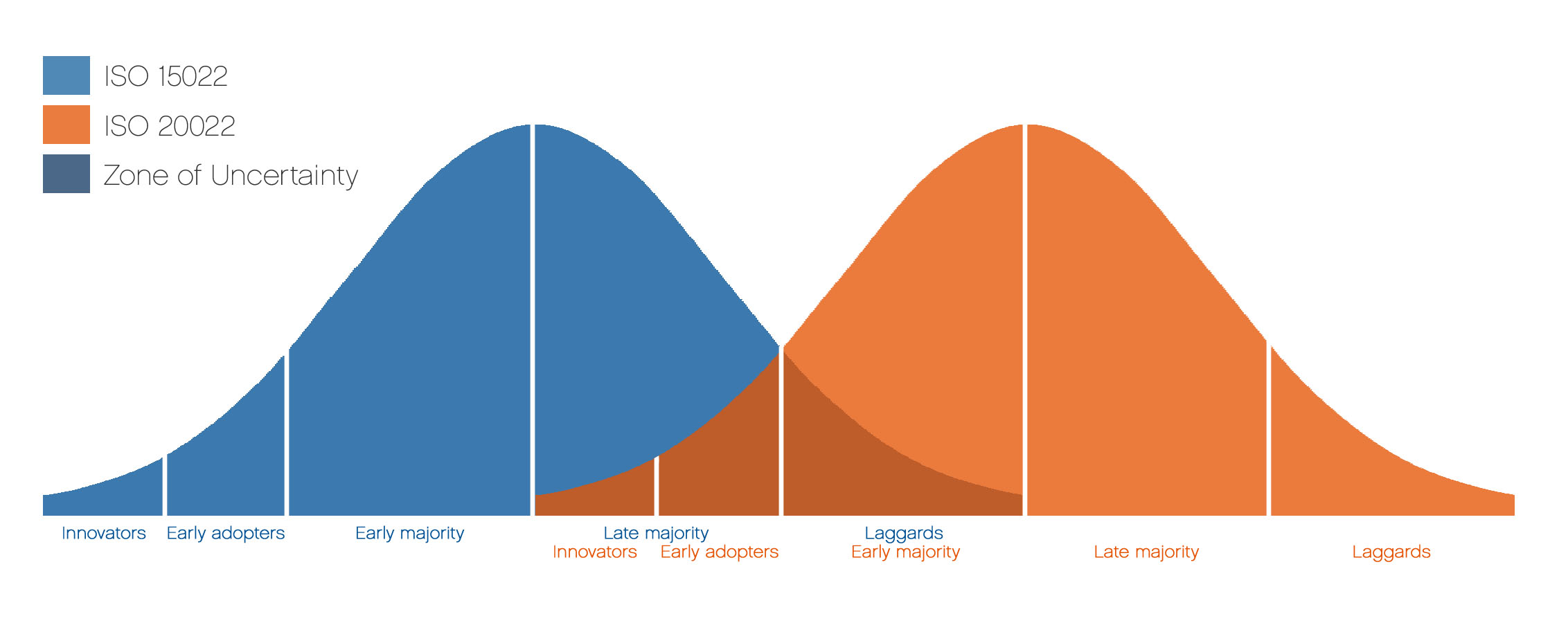 Guest Contributor: Dan Retzer, Managing Director and Chief Technology Officer, XSP
Guest Contributor: Dan Retzer, Managing Director and Chief Technology Officer, XSP
That coexistence between the ISO 15022 and 20022 messaging standards presents challenges to the producers and consumers of financial data is without question. These challenges, however, also yield opportunities for solutions providers, vendors and consultants that possess demonstrated expertise in both standards. This juxtaposition of needs and opportunities is a common pattern expressed in what is referred to as the Technology Adoption Lifecycle. The Technology Adoption Lifecycle is not specifically limited to technology – it actually represents the sociological motivations guiding consumer behaviour when a new technology or product is introduced. That is not to say that the coexistence between ISO 15022 and 20022 standards is a technology challenge. Rather, it stands to reason that the adoption of 20022 will follow a pattern common to most innovations. This pattern will persist until such time as the adoption of 20022 reaches the boundary between the Early Majority and the Late Majority as depicted in the Technology Adoption Lifecycle. Until that time, 15022 will continue as the de facto standard until the market demands otherwise.
The global adoption of 15022 is ongoing, and the overall trend enters what is considered the “Late Majority” phase – that is the point in the adoption curve where the solution has reached sufficient maturity and market penetration to be considered the incumbent – or legacy – solution. This does not indicate that 15022 use is decreasing. In fact, SWIFT’s own usage statistics indicate otherwise. It indicates that the rate of adoption will begin to decline as the standard has reached majority penetration. It is also at this point in the standard’s lifecycle, as is the case with all innovations, where firms that are heavily leveraging the standard begin to demand improvements in the standard to keep abreast of changes in the market or in advances in technology or systems that consume the standard. This signifies a transition from stabilisation to dissatisfaction.
The pattern of adoption, stabilisation and dissatisfaction is repeated time and again and spans multiple industries and innovations. It is not unique to the current state of standards coexistence between 15022 and 20022, and it is reasonable to expect that reaction to this pattern observed in other industries will be mirrored in the 15022/20022 debate. The Technology Adoption Lifecycle predicts that when the incumbent solution, such as 15022, reaches the downhill slope of the adoption curve and becomes the state of practice, a number of gaps begin to emerge that prevent it from growing. These gaps are usually tied to an inability to scale, inflexibility in the standard, or failure of the standard to remain relevant with the pace of change in related industries.
The incumbent attempts to remain relevant through stepwise improvement, but over time these changes inflict large amounts of disruption into the consumer base on a more frequent basis. It is during this period, when a standard or technology has reached extensive adoption that the cracks begin to show and a new standard is posited in response.
Thus begins a new Technology Adoption Lifecycle as a new standard is developed and marketed. This new lifecycle, however, introduces an additional layer of disruption when the market is already dealing with maintaining the previous standard. Consumers are now torn between waiting for the new standard to stabilise and deal with the shortcomings of the incumbent standard or to leap the next Early Adopter Gap with the faith that this jump will yield the improvements and innovation promised by the new standard and eliminate the costly maintenance cycle of the incumbent. The result is overlapping Technology Adoption Lifecycles with no clean dovetail from the incumbent solution to the innovation.
This point in time where two or more disruptive activities overlap becomes a Zone of Uncertainty and is fertile ground for entrepreneurs and solutions providers alike. Solutions providers (software companies, consultants, device manufacturers, etc.), who are already in the business of solving complex, risky problems for industry at large, recognise that these periods of overlap yield opportunities to assist their clients with supporting their legacy paradigm while helping them navigate to the innovative, new standard.
The financial community’s stand is clear; it wants and needs standards that drive efficient market operations and transparency. However, adoption in various business models heeds different obstacles. Some challenges can be addressed using existing resources while the majority will require new resources, sustained financial investment and significant collaborative effort. Although some firms are already taking bold steps to adopt 20022, many are still only capable of using 15022. If 15022 were to reach end-of-life today, the challenges of standardisation will continue to impact the industry for years to come. Legacy application integrations, lack of understanding the broader picture and the absence of demonstrative business cases are increasingly compromising the advance to adopt the latest 20022 standard. Adopting the ISO 20022 standard in response to improving straight-through processing and the quality of information flow presents a significant challenge for many firms. As a result, uncertainty leads to coexistence.
The coexistence between the 15022 and 20022 standards for firms that are dependent upon the reliable and consistent delivery of data utilising the incumbent standard are also beginning to see the deficiencies in the standard. These deficiencies require either costly or disruptive changes to overcome, or require the adoption of a new set of standards. In many cases, it will be necessary to maintain two sets of parallel systems or operations to account for the different standards. In other instances, it may require new systems to manage the conversion from one standard to another. But in all instances, there is opportunity for solutions providers, vendors and consultants to assist firms with the management of both standards and the eventual migration from the legacy standard.



Leave a Reply